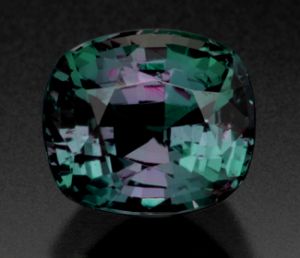by Richard W. Wise, G.G.
©2012 all rights reserved.
Of Tilt-Windows, Off-center culets and other minor issues:

The image of the gem quality 1.44 carat alexandrite might lead the uncritical observer to conclude that the gem is windowed. What the gem is actually exhibiting is some extinction beneath the table. In a perfect world, both are minor faults, but we are talking about the rarest gem on earth. In the world of true rarity, beauty not mathematical perfection of symmetry is the ultimate criterion.
The first time I ever heard the term tilt-window was on the Pricescope forum. As you know, a window is a part of the gem when viewed face-up that exhibits transmitted light. Windows are almost always found right beneath the table. A quick test is to place the stone over a piece of newsprint. If you can read the print, you are looking through a window. Windows are the result of a shallow pavilion, a too shallow depth to width ratio. Windows are considered faults because they are a portion of the gem that does not sparkle.
Gem cuts are designed and engineered to be judged face-up with light perpendicular to the table. Tilt the gem away from the perpendicular and every gem other than a briolette will exhibit a window. Ironically the more precise the cut, the more likely the gem is to window when tilted as little as five degrees from the perpendicular. Some gems, particularly those with a bit of fat around the pavilion, may exhibit some brilliance when tilted as much as ten to fifteen degrees from the perpendicular. What cannot be eliminated must be embraced. A tilt window, forgetaboutit!
Grading; From Minus To Plus:
Gems with bulbous pavilions are often criticized for being overweight, meaning that the stone’s face is smaller than it would be if the stone was perfectly cut. The irony here is that such stones may actually exhibit a greater arc of brilliance which contributes to the beauty of the gem. Once the eye is four to five feet from the gem, the overall brilliance becomes the real issue, not the stone’s mathematical diameter. Broader bellies also extend to the length of the light path and may enrich the color (hue, saturation and tone) of the gem.
In another Pricescope thread, one ubiquitous poster put a link to an alexandrite (pictured above) on my website and criticized me for the failure to disclose an off-center culet. How did this forum member determine that the stone had such a terrible fault? The page included a side view image of the stone face-down. If there was an attempt to hide the fault, it was hidden in plain sight. http://www.rwwise.com/products/id,255 Unfortunately her interpretation of the image was quite wrong. The stone does not have an off-center culet. What the forum member saw was a very minor symmetry fault, one side of the pavilion has a slight indent coupled with a tilted crown which when placed on a flat surface caused the culet to appear off-center. And if the gem did have a slightly off-center culet, so what! We are talking about one of the earth’s rarest treasures, a gem quality alexandrite!
Each Gem Is an Individual with a distinct personality and should be judged on its merits:
Gem aficionados usually begin their love affair with the colorless diamond. They learn the famous 4 C’s and attempt to apply those criteria, namely color, clarity cut and carat weight uncritically to colored gemstones. As I have said elsewhere all Cs are not created equal. In the connoisseurship of colorless diamond, cut is the 1st and most important criterion. Diamonds have no color, they are all about brilliance and sparkle, so naturally cut, which delivers sparkle is the most important single criterion. I knew a neophyte jeweler once who was not satisfied with eye-flawless sapphires, he demanded that all of his sapphires be flawless under 10x magnification. The problem, without inclusions it is almost impossible to determine if a stone has been enhanced and determination of geographic origin is absolutely impossible.
Colored gemstones as their name suggest are all about color and cut is, at best, a secondary consideration. An off-center culet in a diamond would be a major symmetry fault and materially effect price. In a colored gem, an off-center culet in and of itself is a minor fault which has no effect on price. Why do such things exist? A culet might appear off-center for a couple of reasons. The lapidary may have removed a potentially eye visible inclusion or have placed the culet slightly askew to smooth out color zones so that the zone does not appear in the gem when viewed face-up.
It should be remembered that colorless diamonds are not truly rare. The introduction of cut and clarity scales that have nothing to do with beauty are more about creating the appearance of rarity than the thing itself. The connoisseurship of gemstones requires discernment and careful contemplation. Gems cannot be accurately graded by image. The aficionado should beware attempts to reduce it to a formula or a check list.
